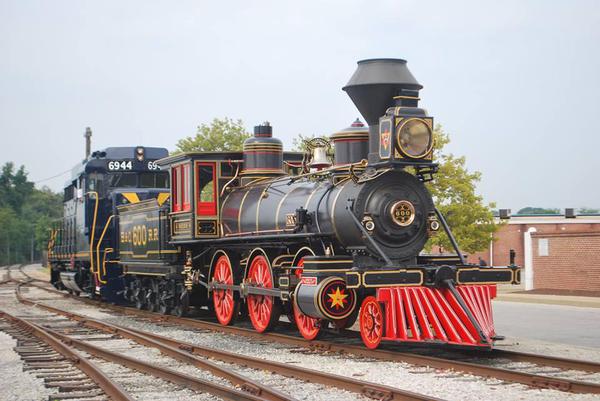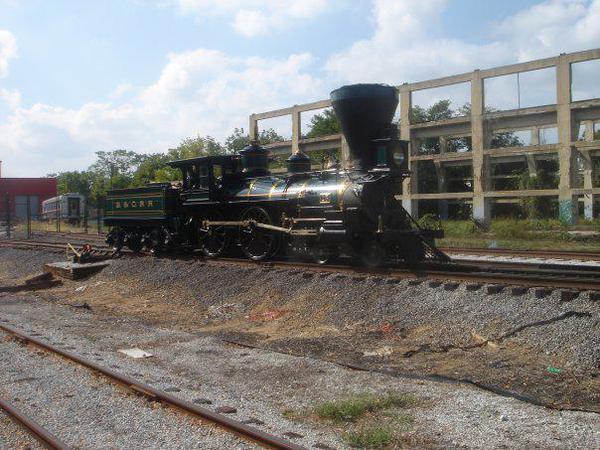The B&O Museum will be unveiling two new restorations. Hopefully they will turn their attention to long neglected pieces outdoors that are in dire need of attention now that they are finished with the roof collapse victims.
"The B&O Railroad Museum is proud to announce the completion of two locomotive restoration projects:
- No. 600 “J.C. Davis:” one of America’s rarest steam engines and the last steam engine to be restored that was damaged in the catastrophic 2003 roundhouse roof collapse.
- No. 6944: General Motors Electro-Motive Division (GM-EMD) GP30, the only class of locomotives delivered to the B&O Railroad in the sunburst paint scheme.
Both locomotives will be unveiled and commemorated by the museum’s executive director, Courtney Wilson and chief curator, David Shackelford on the morning of Friday, September 4th. To honor the efforts of the Museum’s restoration team, public programs on both engines will take place throughout the day.
The No. 600 was designed by John C. Davis, the B&O’s Master of Machinery, and built at the historic Mount Clare shops (now the site of the Museum); this powerful locomotive type with 2 leading wheels, 6 driving wheels and no trailing wheels (2-6-0) was known as a "Mogul." The derivation of the name is unknown but is thought to represent a powerful leader. Originally engines like this were designed for freight service; however Davis also decided to use the versatile locomotives for passenger service. The B&O displayed the No. 600 as a “state-of-the-art” steam locomotive in Philadelphia during the Centenary Exhibition in 1876. It won first prize for its attractive design and color scheme. The No. 600 served until it was retired in 1893 when it became part of the historic collection of the railroad. It was renamed J.C. Davis, for its designer in 1927 for the railroad’s 100th anniversary celebration known as the Fair of the Iron Horse. It has been meticulously restored to its original appearance by the restoration staff of the B&O Railroad Museum and it is the only B&O Mogul locomotive in existence. The No. 600 was one of the twenty-two locomotives and railcars that were severely damaged by the roundhouse roof collapse during the President’s Day blizzard of 2003. Its restoration was complex due to the extreme level of damage it sustained and its completion is a testament to all who contributed and worked hard to rebuild the roundhouse and save the historic collection housed within.
The No. 6944 was one of 77 engines built for the B&O Railroad by General Motors Electro-Motive Division in La Grange, Illinois between 1961-1963. This 4-axle roadswitcher is more commonly known as a “General Purpose” or GP locomotive. The B&O No. 6944 is a second generation GP 30 locomotive developed to out power its competitors made by General Electric and the American Locomotive Company (ALCO). The exterior shell was designed by the GM Automotive Styling Center in Troy, Michigan to have a modern, appealing and cutting edge design. Less than 1,000 units were made and the B&O boasted 77 of them on their motive power roster. The locomotives in this class were the only class of locomotives delivered to the B&O in a unique sunburst paint scheme. When the B&O ceased to exist in 1987, it was renumbered as CSXT No. 4253. On January, 22, 1996, CSX retired the locomotive and donated it to the B&O Railroad Museum. The restoration returns the 6944 to its original appearance. It will return to service as one of the historic diesel engines pulling the museum’s passenger train.
WHEN: Friday, September 4, 2015
10:00 a.m. – 4:00 p.m.
WHERE: Baltimore & Ohio Railroad Museum
901 West Pratt Street
Baltimore, Maryland 21223
410-752-2490
FREE PARKING"
EDITED BY THE WEBMASTER to fix some formatting issues.
No content was changed.














